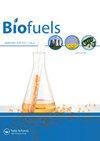Environmental footprint evaluation of Jatropha biodiesel production and utilization in Ethiopia: a comprehensive well-to-wheel life cycle analysis
IF 2.6
4区 工程技术
Q3 ENERGY & FUELS
引用次数: 0
Abstract
AbstractIn Ethiopia, a Life Cycle Analysis of Jatropha-based biodiesel was conducted using the Greenhouse Gases, Regulated Emissions, and Energy Use in Transportation model to assess energy consumption, efficiency, and greenhouse gas (GHG) emissions in the well-to-tank (WTT) and well-to-wheel stages. The inventory analysis involved field surveys and scenarios to evaluate energy savings, emission reductions, and air pollutants in biodiesel-diesel blends. In the WTT analysis, the energy consumption for producing 1 MJ of Jatropha-based biodiesel was found to be 0.43 MJ under rain-fed and 0.68 MJ under irrigated conditions. The net energy value was positive, and the net energy ratio was higher compared to that in other countries. The results show that GHG emissions at 19.8 g CO2 eq/MJ during the WTT stage can reduce environmental impacts by up to 45–87% depending on the type of irrigation used. When examining the global warming potential, it was found that the cultivation of Jatropha accounted for the highest share of GHG at 57.58%, followed by the biodiesel production process at 23.88%. On the other hand, vehicles employing B20 blend could replace 14.78% of fossil energy use and reduce 13.95% of GHG emissions per km, compared to pure diesel vehicle.Keywords: Jatropha biodieselGHG emissionLife cycle assessmentWell-to-tankWell-to-wheel AcknowledgmentsThe authors would like to acknowledge the German Federal Ministry of Education and Research (BMBF) for funding this research under the framework of the WESA-ITT project. Thanks are also due to the German Development Bank (KfW) for their support in the form of a scholarship to the corresponding author of this article through ExiST project.Author contributionsY.A., performed the data collection and literature review; R.B., V.R., and Y.A. developed the methodology, and performed the data analysis and simulation models; Y.A. and R.B. contributed to writing the paper; R.B. and V.R. reviewed and edited the manuscript; R.B., as a main supervisor, followed up all study steps and gave helpful advice. All authors discussed the results, and read and approved the manuscript. All authors have read and agreed to the published version of the manuscript.Disclosure statementNo potential conflict of interest was reported by the author(s).Data availability statementThe data presented in this manuscript are available on request from the corresponding author.Additional informationFundingGermen Federal Ministry of Education and Research (BMBF) through its Project Management Agency (Pt-DLR) under the framework of WESA-ITT Project with grant No 01DG16010B, and Germen Development Bank (KfW) under ExiST Project with grant No. 51235 funded this research.埃塞俄比亚麻疯树生物柴油生产和利用的环境足迹评价:从油井到车轮的综合生命周期分析
在埃塞俄比亚,利用温室气体、管制排放和运输中的能源使用模型对麻疯树生物柴油的生命周期进行了分析,以评估从井到罐(WTT)和从井到车轮(WTT)阶段的能源消耗、效率和温室气体(GHG)排放。清单分析包括实地调查和场景,以评估生物柴油-柴油混合物的节能、减排和空气污染物。WTT分析发现,雨养条件下生产1 MJ麻疯树生物柴油的能耗为0.43 MJ,灌溉条件下为0.68 MJ。净能值为正,净能比高于其他国家。结果表明:根据灌溉方式的不同,WTT阶段19.8 g CO2当量/MJ的温室气体排放可减少高达45-87%的环境影响。在分析全球变暖潜势时,发现麻疯树的种植占温室气体的57.58%,其次是生物柴油的生产过程,占23.88%。另一方面,与纯柴油汽车相比,使用B20混合燃料的汽车可以替代14.78%的化石能源使用,每公里温室气体排放量减少13.95%。关键词:麻疯树生物柴油;温室气体排放;生命周期评估;从井到罐;从井到轮致谢作者感谢德国联邦教育与研究部(BMBF)在WESA-ITT项目框架下资助本研究。还要感谢德国开发银行(KfW)通过ExiST项目以奖学金的形式支持本文的通讯作者。作者contributionsY.A。进行资料收集和文献综述;r.b., v.r.和Y.A.开发了方法,并进行了数据分析和模拟模型;Y.A.和R.B.参与了论文的撰写;R.B.和V.R.审阅和编辑手稿;r.b.作为主要的指导老师,跟进了所有的学习步骤,并给出了有益的建议。所有作者讨论结果,阅读并批准稿件。所有作者都已阅读并同意稿件的出版版本。披露声明作者未报告潜在的利益冲突。数据可用性声明本文中提供的数据可向通讯作者索取。德国联邦教育和研究部(BMBF)通过其项目管理机构(Pt-DLR)在WESA-ITT项目框架下(资助号01DG16010B)和德国开发银行(KfW)在ExiST项目下(资助号51235)资助了这项研究。
本文章由计算机程序翻译,如有差异,请以英文原文为准。
求助全文
约1分钟内获得全文
求助全文
来源期刊

Biofuels-Uk
Energy-Renewable Energy, Sustainability and the Environment
CiteScore
5.40
自引率
9.50%
发文量
56
期刊介绍:
Current energy systems need a vast transformation to meet the key demands of the 21st century: reduced environmental impact, economic viability and efficiency. An essential part of this energy revolution is bioenergy.
The movement towards widespread implementation of first generation biofuels is still in its infancy, requiring continued evaluation and improvement to be fully realised. Problems with current bioenergy strategies, for example competition over land use for food crops, do not yet have satisfactory solutions. The second generation of biofuels, based around cellulosic ethanol, are now in development and are opening up new possibilities for future energy generation. Recent advances in genetics have pioneered research into designer fuels and sources such as algae have been revealed as untapped bioenergy resources.
As global energy requirements change and grow, it is crucial that all aspects of the bioenergy production process are streamlined and improved, from the design of more efficient biorefineries to research into biohydrogen as an energy carrier. Current energy infrastructures need to be adapted and changed to fulfil the promises of biomass for power generation.
Biofuels provides a forum for all stakeholders in the bioenergy sector, featuring review articles, original research, commentaries, news, research and development spotlights, interviews with key opinion leaders and much more, with a view to establishing an international community of bioenergy communication.
As biofuel research continues at an unprecedented rate, the development of new feedstocks and improvements in bioenergy production processes provide the key to the transformation of biomass into a global energy resource. With the twin threats of climate change and depleted fossil fuel reserves looming, it is vitally important that research communities are mobilized to fully realize the potential of bioenergy.
 求助内容:
求助内容: 应助结果提醒方式:
应助结果提醒方式:


